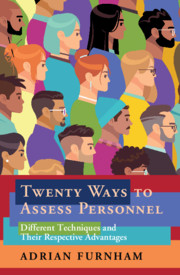Book contents
- Twenty Ways to Assess Personnel
- Twenty Ways to Assess Personnel
- Copyright page
- Dedication
- Contents
- Tables
- Preface
- Acknowledgements
- 1 Introduction to Selection and Assessment
- 2 Complex and Sticky Issues in Assessment and Selection
- 3 Traditional and Mainly Discredited Assessment Methods
- 4 Self-Report Tests
- 5 Observer Reports
- 6 Behavioural Tests
- 7 Physiology
- 8 Biography
- 9 Big Data
- 10 The Future of Assessment
- Index
- References
8 - Biography
Published online by Cambridge University Press: 11 June 2021
- Twenty Ways to Assess Personnel
- Twenty Ways to Assess Personnel
- Copyright page
- Dedication
- Contents
- Tables
- Preface
- Acknowledgements
- 1 Introduction to Selection and Assessment
- 2 Complex and Sticky Issues in Assessment and Selection
- 3 Traditional and Mainly Discredited Assessment Methods
- 4 Self-Report Tests
- 5 Observer Reports
- 6 Behavioural Tests
- 7 Physiology
- 8 Biography
- 9 Big Data
- 10 The Future of Assessment
- Index
- References
Summary
This chapter deals with how the past influences the present and the future: that is, how the personal history/biography of an individual explains the present and predicts the future. It describes in detail a very specific area in psychology assessment called biodata, which is an attempt to ‘score an application form’. While there are different methods, they all rely on giving weights to past experiences, which have been shown to predict future behaviour. It tests the claim like you can ‘see leaders in the school playground’: meaning there are many early markers of later behaviour. Much of the chapter looks at describing what does and does not constitute real biodata and the evidence for its validity as an assessment technique. The second half of the chapter looks at how psychologists have examined autobiographies, psychobiographies as well as ‘typical’ biographies to look for the clues to the motives and behaviour of individuals. Features such as birth order and the misfortunes of youth are thought to have a powerful impact on individuals. An example of this approach is the analysis done of Mrs Margaret Thatcher.
- Type
- Chapter
- Information
- Twenty Ways to Assess PersonnelDifferent Techniques and their Respective Advantages, pp. 434 - 473Publisher: Cambridge University PressPrint publication year: 2021



